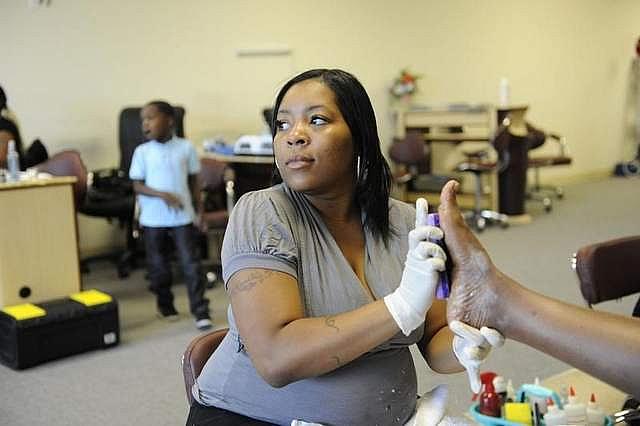Mothers, m-health and the messy space: My favorite health stories of 2014 (Part 1)

Karen Bouffard’s story on Detroit's high maternal death rate featured Kanitra Patterson, who developed a potentially fatal heart condition while pregnant. (Photo by David Coates / The Detroit News)
The California Endowment Health Journalism Fellowships provide journalists from rookies to veterans the chance to work on passion projects while developing beat skills that will help them throughout their career. Every Health Journalism Fellow I know has benefited from the experience. Every year I look at my list of best health stories from the previous 12 months and find more and more fellows in the list. This year, I am featuring my favorite work in 2014 from reporters who have gone through the fellowship. I’ll have three today and three more in my next post.
1. Karen Bouffard is a health care reporting newcomer. She started the beat in January 2013, and, with the help of the fellowship, generated some hugely impactful stories, including an investigation published in January 2014 that analyzed child death rates and causes in Detroit. It was called “Surviving through age 18 in Detroit.” By September 2014, her work was so well known that she was invited to speak to the Institute of Medicine. She followed that work up with a great examination of maternal deaths in Detroit: “Detroit’s maternal death rate triples the nation’s.”
What I love about all of Bouffard’s work is how she spends time explaining the inequities in health in her community and also the things that are masking those disparities. One reason inequality in maternal health has continued unabated for so long is that it is hidden by national level statistics. As Bouffard writes:
Officials admit that reliable statistics by which maternal death rates can be compared among cities and states are difficult to come by, because there are no national reporting standards. Michigan is among 41 states with a question or checkbox on death certificates related to pregnancy status. As states add such a checkbox, their maternal mortality rates increase due to better reporting. There also is no uniform reporting requirement among Michigan’s 83 counties. To circumvent that lack of data, the Michigan Maternal Mortality Surveillance System — a collaboration of the state health department, Michigan State Medical Society and medical schools — matches death records of women with birth records, and reviews deaths of women who died while pregnant or within one year of termination of pregnancy, irrespective of cause.
2. Eryn Brown at the Los Angeles Times blew past the hype around mobile health technologies with the help of the fellowship. She wrote about how researchers are testing the efficacy of smartphones to lower the rate of sexually transmitted diseases, and how mobile applications may help women with weight problems improve their diets and become more physically active.
The technological advances are real and the potential for huge health benefits is real, too. Brown makes that clear and compelling. She also did a great job describing the things that could lead to greater health disparities if these advances and improvements are only available in urban areas that have the right infrastructure. She wrote about Dr. Earl Ferguson, a cardiologist at Ridgecrest Regional Hospital in Kern County:
With 25 inpatient beds, it offers more comprehensive services than most rural critical-access hospitals, Ferguson said. In a conference room, he tried to demonstrate a tablet-based electronic health records system, but it kept freezing up — possibly, he thought, because rebar buried in the walls interfered with his Wi-Fi signal. Even with the new Internet line in the area and upgrades within the hospital, connectivity issues are a common occurrence, he said, because most businesses and homes in the region still depend on pokey technology to link into the backbone network.
‘I've had the telemedicine system go down over shared DSL because someone was watching Netflix,’ he said.
Remember that Brown is writing about California – a state with one of the 10 largest economies in the world. If m-health is slow to get started there, what does that mean for the rest of the country – and the world?
3. Tim Darragh at The Morning Call in Allentown used the fellowship to work on Sick System, a great examination of the health care system in eastern Pennsylvania’s Lehigh Valley. He found huge problems and the drivers of those problems, but he also found successes, like the ones he described in “Keeping people out of hospitals makes system healthier.” The Lehigh Valley Super-Utilizer Partnership took inspiration from Dr. Jeffrey Brenner – famous for his research into how “hot spotters” can manage patients who disproportionately use more health care resources than everyone else. Darragh, who left a long and lauded career at The Morning Call to join the Star-Ledger in Newark, New Jersey, wrote about patients such as, Jenny Hassan, an emergency room frequenter who had been in some legal trouble.
So instead of shaming Hassan, the partnership got into what Brenner calls the ‘messy space’ — a relationship that's closer and more personal than the traditional doctor-patient relationship, with the end goal of autonomy for Hassan. The team instructed her on managing her medical problems and gave her a binder of information with easy-to-understand instructions. They visited Hassan, occasionally accompanied her to doctor appointments and prayed with her. … Hassan also cut back on her emergency room visits. ‘There were months where I didn't go to the emergency room,’ she said from her apartment a few blocks from St. Luke's University Hospital in Fountain Hill.
Darragh is a good reporter, though, and so he shows how Hassan also ended up back in the emergency room and how the Lehigh Valley partnership did not give up on her.
Next: Three more of my favorite health stories from the past year.
Photo by David Coates/The Detroit News.

